Geochemical Characteristics and Metal Enrichment Rules of Black Shales in the Zhuxi Vanadium Ore Field, Eastern Guizhou
-
摘要: 目前急需分析黔东注溪钒矿形成的环境、成矿的物质来源以及矿化富集规律,指导实际地质勘查工作.系统研究了注溪矿区内中洞、老屋基和坪哨3个典型岩性剖面中黑色岩含矿岩系及矿层的全岩主微量元素组成.结果表明,含矿岩系具有较高的SiO2、MnO、Ce/Ce*和Eu/Eu*值,而矿层则含相对较高的Al2O3、Fe2O3、TiO2、CaO、Na2O、K2O、P2O5、V2O5、REE、As、Cu、Pb、Zn、Mo、Ni、Ti、Cr、Rb、Sr、Th、U和V.含矿岩系与矿层的主微量地球化学特征显示注溪钒矿床的成矿物源具有一定程度陆源物质的输入,且在成矿阶段受到了热水作用及生物作用的影响.另外,由南至北各剖面的热水成矿作用逐渐减弱;含矿岩系及矿层沉积环境均属缺氧环境,其中坪哨剖面的矿层沉积环境的缺氧程度要高于其他剖面.因此,注溪钒矿床钒富集成矿主要受古环境的还原条件和热液活动的影响,其中还原环境对钒元素的富集成矿起主要作用.据此推测坪哨剖面矿层形成时的海水深度应最深,北矿段中洞剖面的最浅;喷流热水带来的V等大量多金属元素在喷口及其附近大规模成矿.Abstract: There is an urgent need to analyze the forming environment,the metal enrichment process and ore-forming rules of the Zhuxi vanadium ore field in eastern Guizhou Province. This paper systematically studies the major and trace element compositions of ore-bearing rocks and ore strata from three typical black shale sections in the ore field. The results show that ore-bearing rocks contain high contents/values of SiO2,MnO,Ce/Ce* and Eu/Eu*,while ore strata have higher concentrations of Al2O3,Fe2O3,TiO2,CaO,Na2O,K2O,P2O5,V2O5,REE,As,Cu,Pb,Zn,Mo,Ni,Ti,Cr,Rb,Sr,Th,U and V. The major and trace element geochemical characteristics of ore-bearing rocks and ores indicate that the ore-forming source of the Zhuxi vanadium ore field had a certain degree of continental material input,whilst both hydrothermal and biological processes played a significant role during the ore-forming process. In addition,the intensities of hydrothermal process decreased from southern to northern sections and the sedimentary environment of both ore-bearing rocks and ores was anoxic. The ores from the Pingshao lithological sections were formed in the most reducing environment than those from other sections. Therefore,the V enrichment and mineralization in the Zhuxi ore field has mainly been controlled by reducing paleoenvironment and hydrothermal activity,and the reducing environment has been more significant for V mineralization. It can be inferred that ores from the Pingshao section should have been deposited in the deepest seawater environment while the ores from northern Zhongdong section had the shallowest seawater level. Exhalative fluid brought abundant V and other metal elements depositing in the vent and adjacent areas,leading to the large-scale mineralization.
-
0. 引言
对承压含水层在人类开采作用下地下水的非稳定流动, 自1935年著名的Theis公式[1]被提出以来, 传统的地下水渗流理论对之进行了近70年的分析研究, 建立了一系列对应各种条件的承压含水层井流解析模型.这些模型为解释承压含水层井流现象、分析抽水试验数据、辩识含水层参数乃至地下水资源的管理提供了重要的理论工具, 已经发挥了巨大的作用.
然而, 对于实际观测到的地下水渗流-含水介质变形的一些耦合现象, 包括承压含水层非稳定井流和盖层弯曲的相互作用, 这些传统的理论模型还无法解释, 尽管这些现象有时看起来是微弱的、难以觉察的.随着人类观测技术水平的不断提高和对地质变化敏感度的加强, 这种发生在含水层体系中的渗流-变形耦合现象也越来越得到关注.为了解释这些现象, 需要从理论上突破传统承压含水层模型的一些不合理假设.例如: 为了解释所谓的“Noordbergum效应” (在承压含水层抽水时, 上部或下部的弱透水层发生快速的小幅度的水头上升现象), Hsieh[2]、Kim和Parizek[3]利用Boit固结理论分析这些弱透水层的水头波动与含水介质变形的关系, 并进行了有限元计算; 为了解释循环抽水试验中的滞后效应, Burbey[4]应用非线性的应力-应变有限元模型考察含水层压缩与水头变化的响应特征.就含水层的变形行为, Burbey[5]还对传统地下水理论中只考虑垂向变形的做法提出质疑, 他通过数值分析认为, 在抽水条件下有多达50%的地下水是通过含水层的横向变形释放的.
陈崇希和吴修义[6]在分析一个无越流承压含水层的抽水试验时发现, 抽水初期(50 min内) 水头降深显著大于用Theis公式计算的结果.“显著”是指具有可观测性, 在抽水井径距r=104 m, 观测孔的最大偏差超过3 cm, 显然随径距r的减小偏差值会增大.他们提出, 这种现象的一个重要原因是含水层顶板发生弯曲, 起到了“梁”的作用, 抵消了部分荷载, 从而使水头降深超过Theis公式的估计值.王旭升和陈崇希[7]采用有效应力原理进一步分析了无越流承压含水层井流-盖层弯曲效应的机制, 通过引入弹性薄板理论, 建立了初步的解析模型来探讨顶板弯曲可能对无越流承压含水层井流造成的影响, 证明Theis公式计算的抽水降深是偏小的.然而, 这一改进模型忽略了水的压缩性, 也没有考虑越流, 需要加以完善.
笔者认为, 承压含水层井流-盖层弯曲效应是不同于上述Noordbergum效应和滞后效应的一种含水层变形-地下水渗流耦合作用, 后两者发生在未固结或弱固结的含水层体系(如第四系含水层), 而前者不仅会发生在未固结或弱固结的含水层体系中, 还会发生在已固结的基岩含水层体系中, 需要不同于Biot固结模型的理论加以解释.本文之目的, 就是建立一个相对较完善的解析理论, 用于分析无越流和有越流的承压含水层井流-盖层弯曲效应(以下简称井流-弯曲效应).
1. 应力分析
根据有效应力原理, 承压含水层总应力σ、有效应力σ′和孔隙水压力p之间的关系为[8]

(1) 因此增量关系为

(2) 当在含水层抽水时, 含水层孔隙水压力变化与水头降深s存在对应关系

(3) 其中, γw为水的容重.有效应力变化与含水层的压缩量存在对应关系

(4) 其中, w为承压含水层的压缩量, 即顶板垂直向下的弯曲挠度, α是含水层骨架的压缩系数, M为承压含水层的厚度.
文献[7]已经推导出, 假定含水层底板不变形, 在单位水平面积的含水层柱体中由于水头降深(水膨胀) 和有效应力增大(骨架压缩) 导致的水体积变化ΔV为

(5) 其中, n是含水层的孔隙度, β是水的压缩系数.
传统的地下水理论假定承压含水层的总应力不随抽水过程变化, 因此Δσ′=γws.用ΔV′表示这种假定条件下单位面积的释水量, 则有

(6) 其中

(7) 本文将μm称为含水层骨架压缩给水度, 将μw称为地下水膨胀给水度, 两者与我们所熟知的承压含水层弹性给水度μe的关系为

(8) 因此, 传统的承压含水层给水度概念, 是建立在假定总应力不变这一基础上的.
本文考虑承压含水层顶板的弯曲, 因此不再假定总应力守恒, 含水层单位面积的释水量应该为ΔV.根据(2) 式有

(9) 把(9) 式和(6) 式代入(5) 式, 得到

(10) 由于含水层顶板弯曲产生支持力, 抵消了一部分铅直荷载, 导致总应力下降, 有Δσ < 0, 从而ΔV < ΔV′.这说明在相同的降深条件下, 受承压含水层顶板弯曲的影响, 地下水的释放量小于传统理论的估计.因此, 为了保持水均衡, 在抽水井附近就会产生更大的抽水降深.
把(3)、(4)、(7) 式代入(2) 式, 得到总应力变化的表达式

(11) 因此总应力变化是由承压含水层的抽水降深和顶板的弯曲挠度同时决定的.
上述应力分析表明, 井流-弯曲效应的实质是承压含水层盖层弯曲导致含水层总应力下降, 诱发比传统理论估计更大的抽水引起的水头降深.
2. 无越流承压含水层的解析模型
考虑一无越流的均质各向同性承压含水层, 水平无限延伸, 有一口完整井抽水, 抽水流量恒定为Q, 如图 1所示.在水平面上以井心为原点, 建立轴对称解析模型.同时, 假定顶板的弯曲符合弹性薄板理论.
2.1 数学模型及解析解
承压含水层中地下水的径向流方程为

(12) 其中, ∂(ΔV)/∂t是单位面积含水层柱体内水体积(贮水量) 的变化率, T为导水系数, q (r, t) 为源汇项, r表示径向距离, t表示时间.在本文中, 假定顶板的挠度(即含水层的压缩量) 较小, 从而导水系数T的变化可以忽略.
把(4)、(5) 两式代入上式, 得到

(13) 在此, 承压含水层总应力的减少量就是导致盖层(顶板) 发生弯曲的附加荷载, 根据弹性薄板理论[9], 挠曲方程为

(14) 其中D为挠曲刚度,

(15) 式中E、v、b分别为顶板的弹性模量、泊松比和厚度.
(13) 和(14) 式为无越流承压含水层井流-弯曲效应的控制方程.此外, 这一问题的初始条件为

(16) 边界条件分别为

(17) 
(18) 
(19) 
(20) 其中(17) 式反映的是抽水井条件, rw为抽水井的有效半径.
方程(13)、(14) 和(16) ~ (20) 共同构成了无越流承压含水层井流-弯曲效应的数学模型.利用Hankel变换和逆变换可以求出该问题的解析解为

(21) 
(22) 其中

(23) 
(24) 而J0 (x) 是一类零阶Bessel函数.
通过适当变换, 降深的解析解可以表示为无量纲的形式

(25) 其中M为一积分函数

(26) 而无量纲因子分别为

(27) 
(28) 在以下3种情况下, 该降深解析解退化为Theis公式

(29) 
(30) 
(31) 其中W是Theis井函数.这3种情况的物理意义分别为: 公式(29), 含水层顶板挠曲刚度为无穷大, D=∞, 即组成顶板的物质极端坚硬; 公式(30), 含水层顶板挠曲刚度为零, D=0, 即组成顶板的物质极端柔软; 公式(31), 含水层骨架不可压缩, 其弹性给水度等于地下水的膨胀给水度.
2.2 对比分析
新的降深解析解表明, 在井流-弯曲效应中, 水头降深受到3个综合参数的控制: a、c和φ.其中: a是Theis公式中原有的参数, 取决于承压含水层的水文地质性质; c和φ是考虑井流-弯曲效应引入的新参数, c反映了顶板抗弯曲的性能, 而φ=μw/μe反映了地下水本身的膨胀对含水层释水的贡献.
图 2给出了井流-弯曲效应下无量纲降深sD随无量纲时间tD的变化曲线, Theis解对应φ=1的情况, 即承压含水层骨架不可压缩, 抽水量完全由地下水的膨胀所提供, 显然这是一种极端的情况.图 2表明, Theis公式估计的抽水降深是偏小的, 偏小的程度在抽水初期可能十分显著(相对误差很大), 随着时间的延长, 新模型的解析解与Theis解接近.地下水膨胀给水度μw占含水层弹性给水度μe的比例越小, 抽水初期Theis解偏小的程度就越大.更多的对比计算可以发现, 井流-弯曲效应形成与Theis公式偏差的幅度, 在抽水井附近是较显著的, 随着离抽水井距离的增大, 偏差呈现减小趋势.
3. 一类越流承压含水层的解析模型
关于一类越流系统的水文地质特征, 见文献[10].本文假定承压含水层底板为不可变形的基岩, 含水层水平无限延伸、均质各向同性.有一完整井在承压含水层中抽水, 流量恒定为Q, 上部潜水含水层中的地下水通过弱透水层向下越流, 但是潜水水位保持不变, 示意图见图 3.假定由弱透水层和潜水含水层组合构成的承压含水层盖层符合以弹性薄板理论为基础的经典线性叠层板(复合材料) 理论, 不考虑弱透水层本身的压密释水, 建立井流-盖层弯曲效应的轴对称分析模型.
3.1 数学模型及解析解
有越流承压含水层地下水径向流方程为

(32) 其中L′=k/m为越流系数, k、m分别为弱透水层的垂向渗透系数和厚度.
在盖层弯曲方面, 一类越流承压含水层与无越流承压含水层相同, 即总应力的减少量就是导致盖层发生弯曲的附加荷载, 挠曲方程保持(14) 式不变.根据经典线性叠层板理论[11], 盖层挠曲刚度是潜水含水层挠曲刚度与弱透水层挠曲刚度的组合, 组合公式在此不赘述.
模型的初始条件和边界条件仍然用(16) ~ (20) 式描述.
因此, 方程(32)、(14) 和(16) ~ (20) 共同构成了一类越流承压含水层井流-弯曲效应的数学模型.同样利用Hankel变换和逆变换可以得到该问题的解析解

(33) 
(34) 其中

(35) 
(36) 而a、c的定义与(24) 式相同, φ的定义见(28) 式.
容易看出, 当L=0, 即弱透水层完全不透水时, 一类越流承压含水层降深和盖层弯曲挠度的解析解退化为无越流承压含水层条件下的解析解.
对于一类越流承压含水层中的非稳定井流, Hantush和Jacob[12]给出了传统理论解, 其无量纲形式为

(37) 其中

(38) 
(39) 根据(34) 式, 在井流-弯曲效应作用下, 一类越流承压含水层单井定流量抽水引起的无量纲降深sD可以表示为以下的井函数

(40) 其中

(41) 3.2 对比分析
与无越流承压含水层井流-弯曲效应下水头降深的无量纲井函数(26) 式相比, 一类越流承压含水层的无量纲降深井函数(41) 式多了一个综合参数B.这一参数反映了弱透水层的越流能力.B越小, 说明通过相邻含水层产生的越流越强烈, 对被开采的承压含水层地下水径向流的影响就越大.参数B已经包含在传统理论解(37) 式中.
现取一组无量纲因子rD=0.1, φ=0, r/B=0.5, 分别采用Theis公式、Hantush-Jacob公式(37)、无越流条件的井流-弯曲效应公式(26) 和一类越流条件的井流-弯曲效应公式(41) 计算无量纲降深sD随无量纲时间tD的变化.计算结果见图 4.
图 4表明有越流的条件下, 开采层的水头降深在抽水初期与无越流条件较为接近, 但随着时间的延长, 其降深值越来越明显的小于无越流条件, 即相邻含水层越流所补充的地下水占抽水量的比例越来越大.Hantush-Jacob公式所估计的水头降深, 也小于有越流条件下井流-弯曲效应的降深值, 随时间延长, 两者都向同一个固定的降深值逼近.这说明盖层的弯曲并不影响有越流承压含水层在达到稳定流时的水头分布.
4. 结论
承压含水层井流-盖层弯曲效应是一种特殊的含水层变形-地下水渗流耦合作用, 没有被传统的地下水动力学理论所认识到.通过应力分析表明, 承压含水层井流-盖层弯曲效应的机制是在开采井抽水条件下, 承压含水层盖层发生弯曲导致含水层总应力下降, 从而诱发比传统理论估计更大的抽水降深.
通过引入弹性薄板理论, 本文建立了无越流和有越流承压含水层井流-盖层弯曲效应的解析模型, 得到2个新的井函数.考虑井流-盖层弯曲效应时, 对无越流承压含水层来说, Theis公式计算的水头降深是偏小的, 对一类越流承压含水层来说, Hantush-Jacob公式计算的降深是偏小的.在有越流条件下, 井流-盖层弯曲效应并不影响最终稳定流所对应的水头分布.无量纲降深的对比分析表明, 传统理论由于不考虑井流-盖层弯曲效应, 在抽水井附近、抽水初期的降深计算可能产生显著的相对误差.
-
图 1 贵州省寒武纪梅树村期岩相古地理简图
Fig. 1. Simplified Cambrian (Meishucun period) lithofacies paleogeographic map of the Guizhou Province
图 7 注溪钒矿含矿岩系与矿层北美页岩标准化稀土配分模式图(a、b)与平均地壳标准化微量元素蛛网图(c、d)
标准化值分别据Haskin(1984)和Yaroshevsky(2006)
Fig. 7. North American shale-normalized REE patterns (a, b) and average crust-normalized trace elements patterns (c, d) for ore-bearing rocks and ores from the Zhuxi V ore field
图 8 注溪钒矿主微量元素图解
a.Al/(Al+Fe+Mn)-SiO2/Al2O3图解;b. SiO2/(K2O+Na2O)-MnO/TiO2图解,据Murray(1994);c. Y-Ho图解;d. REE-La/Yb图解,据Allègre and Minster(1978);e. Th-U图解,据Boström(1983);f. Al2O3/(Al2O3+Fe2O3T)-Fe2O3T /TiO2图解, 据Murray(1994)
Fig. 8. Plots of major and trace elements for the Zhuxi V ore field
图 9 注溪钒矿矿化富集模式简图
据杨剑(2009)修改
Fig. 9. Cartoon-like profile of the mineralization enrichment patterns for the Zhuxi V ore field
表 1 注溪钒矿含矿岩系及矿石特征
Table 1. Characteristics of ore-bearing rocks and ores in the Zhuxi V ore field
岩石名称 矿物成分 结构构造 其他特征 硅质岩 主要矿物成分为硅质,含有少量的粘土矿物、粉砂质碎屑、有机质等.粉砂级碎屑主要成分为石英矿物屑. 硅质呈微-隐晶结构,晶体呈半自形-他形;粘土矿物呈不均匀分布,具有显微鳞片状结构,沿长轴方向定向性排列好. 石英矿物屑,呈次圆状-圆状零星分布,磨圆度和分选性均良好,碎屑矿物成熟度良好.有机质特征为污染状分布. 多金属层 岩性为灰绿色含黄铁矿含炭粘土质粉砂岩,含磷质结核.矿物成分有粉砂级陆源碎屑、粘土矿物、有机质和黄铁矿等.粉砂级陆源碎屑矿物成分以石英矿物屑为主. 粉砂状结构、层纹-条纹-条带状构造. 粉砂级陆源碎屑呈次圆状、圆状,呈层不均匀分布,具有良好的磨圆度和分选性,碎屑矿物成熟度较高.粘土矿物呈显微鳞片状晶体,层状分布.有机质呈层纹状不均匀分布.黄铁矿呈星散状分布,结晶颗粒大小为细-粉-微-隐晶级,粒度 < 0.25 mm,颗粒形态为半自形-他形,粒状晶体. 黑色炭质粉砂岩、炭质粘土岩 岩石矿物成分由陆源碎屑、有机质和泥质等组分组成,其中陆源碎屑成分以石英矿物屑为主. 粉砂质、泥质结构,层纹状、层状构造. 陆源碎屑呈不均匀层纹状分布,表现良好的磨圆度和分选性,呈次圆状、圆状. -
Alibo, D.S., Nozaki, Y., 1999. Rare Earth Elements in Seawater: Particle Association, Shale-Normalization, and Ce Oxidation. Geochimica et Cosmochimica Acta, 63(3-4): 363-372. https://doi.org/10.1016/s0016-7037(98)00279-8 Allègre, C.J., Minster, J.F., 1978. Quantitative Models of Trace Element Behavior in Magmatic Processes. Earth and Planetary Science Letters, 38(1): 1-25. https://doi.org/10.1016/0012-821x(78)90123-1 Anderson, R.F., Fleisher, M.Q., LeHuray, A.P., 1989. Concentration, Oxidation State, and Particulate Flux of Uranium in the Black Sea. Geochimica et Cosmochimica Acta, 53(9): 2215-2224. https://doi.org/10.1016/0016-7037(89)90345-1 Bau, M., Dulski, P., 1996. Distribution of Yttrium and Rare-Earth Elements in the Penge and Kuruman Iron-Formations, Transvaal Supergroup, South Africa. Precambrian Research, 79(1-2): 37-55. https://doi.org/10.1016/0301-9268(95)00087-9 Bolhar, R., Van Kranendonk, M. J., 2007. A Non-Marine Depositional Setting for the Northern Fortescue Group, Pilbara Craton, Inferred from Trace Element Geochemistry of Stromatolitic Carbonates. Precambrian Research, 155(3-4): 229-250. https://doi.org/10.1016/j.precamres.2007.02.002 Boström, K., 1983. Genesis of Ferromanganese Deposits-Diagnostic Criteria for Recent and Old Deposits. Hydrothermal Processes at Seafloor Spreading Centers, 12:473-489. https://doi.org/10.1007/978-1-4899-0402-7_20 Bradley, D.C., 2008. Passive Margins through Earth History. Earth-Science Reviews, 91(1-4): 1-26. https://doi.org/10.1016/j.earscirev.2008.08.001 Bradley, D.C., 2011. Secular Trends in the Geologic Record and the Supercontinent Cycle. Earth-Science Reviews, 108(1-2): 16-33. https://doi.org/10.1016/j.earscirev.2011.05.003 Chang, H.J., Chu, X.L., Feng, L.J., et al., 2009.Redox Sensitive Trace Elements as Paleoenvironments Proxies. Geological Review, 55(1):91-99 (in Chinese with English abstract). http://www.wanfangdata.com.cn/details/detail.do?_type=perio&id=dzlp200901011 Chen, D.R., Wu, B., Yang, E.L., et al., 2014. Geological Characteristics of Polymetallic Layer in Zhuxi V Deposit, Cengu County, Guizhou Province. Western Prospecting Engineering, 26(8):184-187 (in Chinese). Chen, D. Z., Qing, H. R., Yan, X., et al., 2006. Hydrothermal Venting and Basin Evolution (Devonian, South China): Constraints from Rare Earth Element Geochemistry of Chert. Sedimentary Geology, 183(3-4): 203-216. https://doi.org/10.1016/j.sedgeo.2005.09.020 Chen, D. Z., Wang, J. G., Qing, H. R., et al., 2009a. Hydrothermal Venting Activities in the Early Cambrian, South China: Petrological, Geochronological and Stable Isotopic Constraints. Chemical Geology, 258(3-4): 168-181. https://doi.org/10.1016/j.chemgeo.2008.10.016 Chen, Y.Q., Jiang, S.Y., Ling, H.F., et al., 2009b. Pb-Pb Dating of Black Shales from the Lower Cambrian and Neoproterozoic Strata, South China. Geochemistry, 69(2):183-189. https://doi.org/10.1016/j.chemer.2008.12.005 Chen, D. Z., Zhou, X. Q., Fu, Y., et al., 2015. New U-Pb Zircon Ages of the Ediacaran-Cambrian Boundary Strata in South China. Terra Nova, 27(1): 62-68. https://doi.org/10.1111/ter.12134 Chen, H.S., Yang, E.L., Yang, X. D., et al., 2013.Vanadium Deposits in the Lower Cambrian Black Rock Series in Eastern Guizhou Province. Contributions to Geology and Mineral Resources Research, 28(2):230-235 (in Chinese with English abstract). http://www.wanfangdata.com.cn/details/detail.do?_type=perio&id=dzzklc201302010 Chen, L., Zhong, H., Hu, R.Z., et al., 2006.Early Cambrian Oceanic Anoxic Event in Northern Guizhou: Biomarkers and Organic Carbon Isotope. Acta Petrologica Sinica, 22(9):2413-2423 (in Chinese with English abstract). Chen, Y.X., Cui, Y.L., Liao, J.F., et al., 2013.Research and Ore Prospecting Problem of the Lower Cambrian Black Series in Yunnan Province, China. Acta Mineralogica Sinica, 33(4):637-642 (in Chinese with English abstract). http://d.old.wanfangdata.com.cn/Periodical/kwxb201304032 Dai, C.G., Wang, M., Chen, J.S., et al., 2013.Tectonic Movement Characteristic and Its Geological Significance of Guizhou.Guizhou Geology, 30(2):119-124 (in Chinese with English abstract). http://www.wanfangdata.com.cn/details/detail.do?_type=perio&id=gzdz201302008 Fang, W.X., Hu, R.Z., Su, W.C., et al., 2002.Geochemical Characteristics of Dahebian-Gongxi Superlarge Barite Deposits and Analysis on Its Background of Tectonic Geology, China. Acta Petrologica Sinica, 18(2):247-256 (in Chinese with English abstract). http://www.wanfangdata.com.cn/details/detail.do?_type=perio&id=ysxb98200202013 Feng, Y.F., Chen, D.R., Wu, Z.C., et al., 2013. Exploration for Stratum-Controlled Mineralization Enrichment Rules of Zhuxi V Orebody in Cengu County. The Earth, (5):100-104 (in Chinese). Fu, Y., Dong, L., Li, C., et al., 2016. New Re-Os Isotopic Constrains on the Formation of the Metalliferous Deposits of the Lower Cambrian Niutitang Formation. Journal of Earth Science, 27(2): 271-281. https://doi.org/10.1007/s12583-016-0606-7 Gao, P., He, Z. L., Li, S. J., et al., 2018. Volcanic and Hydrothermal Activities Recorded in Phosphate Nodules from the Lower Cambrian Niutitang Formation Black Shales in South China. Palaeogeography, Palaeoclimatology, Palaeoecology, 505: 381-397. https://doi.org/10.1016/j.palaeo.2018.06.019 German, C.R., Elderfield, H., 1990. Application of the Ce Anomaly as a Paleoredox Indicator: The Ground Rules. Paleoceanography, 5(5): 823-833. https://doi.org/10.1029/pa005i005p00823 German, C.R., Holliday, B.P., Elderfield, H., 1991. Redox Cycling of Rare Earth Elements in the Suboxic Zone of the Black Sea. Geochimica et Cosmochimica Acta, 55(12): 3553-3558. https://doi.org/10.1016/0016-7037(91)90055-a Han, T., Zhu, X. Q., Li, K., et al., 2015. Metal Sources for the Polymetallic Ni-Mo-PGE Mineralization in the Black Shales of the Lower Cambrian Niutitang Formation, South China. Ore Geology Reviews, 67: 158-169. https://doi.org/10.1016/j.oregeorev.2014.11.020 Haskin, L.A., 1984. Chapter 4: Petrogenetic Modelling—Use of Rare Earth Elements. Developments in Geochemistry, 2:115-152. https://doi.org/10.1016/B978-0-444-42148-7.50009-5 Jewell, P.W., Stallard, R.F., 1991. Geochemistry and Paleoceanographic Setting of Central Nevada Bedded Barites. The Journal of Geology, 99(2): 151-170. https://doi.org/10.1086/629482 Jenkins, R.J.F., Cooper, J. A., Compston, W., 2002. Age and Biostratigraphy of Early Cambrian Tuffs from SE Australia and Southern China. Journal of the Geological Society, 159(6): 645-658. https://doi.org/10.1144/0016-764901-127 Jiang, S.Y., Pi, D.H., Heubeck, C., et al., 2009. Early Cambrian Ocean Anoxia in South China. Nature, 459(7248): E5-E6. https://doi.org/10.1038/nature08048 Jiang, Y.H., Li, S.R., 2005.A Study of the Fluid Environment of Silicalite of Transitional Precambrian-Cambrian Age in Hunan and Guizhou Provinces. Earth Science Frontiers, 12(4):622-629 (in Chinese with English abstract). doi: 10.1074-jbc.M111.287474/ Jones, B., Manning, D.A.C., 1994. Comparison of Geochemical Indices Used for the Interpretation of Palaeoredox Conditions in Ancient Mudstones. Chemical Geology, 111(1-4): 111-129. https://doi.org/10.1016/0009-2541(94)90085-x Kamber, B.S., Webb, G.E., 2001. The Geochemistry of Late Archaean Microbial Carbonate: Implications for Ocean Chemistry and Continental Erosion History. Geochimica et Cosmochimica Acta, 65(15): 2509-2525. https://doi.org/10.1016/s0016-7037(01)00613-5 Kimura, H., Watanabe, Y., 2001. Oceanic Anoxia at the Precambrian-Cambrian Boundary. Geology, 29(11): 995. https://doi.org/10.1130/0091-7613(2001)029 < 0995:oaatpc > 2.0.co; 2 doi: 10.1130/0091-7613(2001)029<0995:oaatpc>2.0.co;2 Lan, Z. W., Li, X.H., Chu, X. L., et al., 2017. SIMS U-Pb Zircon Ages and Ni-Mo-PGE Geochemistry of the Lower Cambrian Niutitang Formation in South China: Constraints on Ni-Mo-PGE Mineralization and Stratigraphic Correlations. Journal of Asian Earth Sciences, 137: 141-162. https://doi.org/10.1016/j.jseaes.2016.12.046 Li, S.S., Wei, G.F., Nie, J.T., et al., 2012.The Geological and Geochemical Characteristics of Shuigou Vanadium Deposit in Southern Qinling and Its Genesis.Geoscience, 26(2):243-253 (in Chinese with English abstract). http://www.wanfangdata.com.cn/details/detail.do?_type=perio&id=xddz201202004 Li, Z.X., Bogdanova, S.V., Collins, A. S., et al., 2008. Assembly, Configuration, and Break-Up History of Rodinia: A Synthesis. Precambrian Research, 160(1-2): 179-210. https://doi.org/10.1016/j.precamres.2007.04.021 Li, Z.X., Li, X.H., Kinny, P.D., et al., 2003. Geochronology of Neoproterozoic Syn-Rift Magmatism in the Yangtze Craton, South China and Correlations with other Continents: Evidence for a Mantle Superplume that Broke Up Rodinia. Precambrian Research, 122(1-4): 85-109. https://doi.org/10.1016/s0301-9268(02)00208-5 Ling, H.F., Chen, X., Li, D., et al., 2013. Cerium Anomaly Variations in Ediacaran-Earliest Cambrian Carbonates from the Yangtze Gorges Area, South China: Implications for Oxygenation of Coeval Shallow Seawater. Precambrian Research, 225: 110-127. https://doi.org/10.1016/j.precamres.2011.10.011 Lu, G.Z., 2013. Geological Characteristics and Clues for Prospecting of Zhuxi V Deposit in Cengong. Mineral Resources and Geology, 27(3):217-221 (in Chinese with English abstract). http://www.wanfangdata.com.cn/details/detail.do?_type=perio&id=kcydz201303007 Mao, J.W., Lehmann, B., Du, A.D., et al., 2002. Re-Os Dating of Polymetallic Ni-Mo-PGE-Au Mineralization in Lower Cambrian Black Shales of South China and Its Geologic Significance. Economic Geology, 97(5): 1051-1061. https://doi.org/10.2113/gsecongeo.97.5.1051 Mao, Z.C., Du, Y.S., Zhang, M., et al., 2008.Devonian Sedimentary Environment and Sedimentary Organic Matter Characteristics of Central Guangxi Province. Science in China (Series D), 38(S2):80-86 (in Chinese). Marchig, V., Gundlach, H., Möller, P., et al., 1982. Some Geochemical Indicators for Discrimination between Diagenetic and Hydrothermal Metalliferous Sediments. Marine Geology, 50(3): 241-256. https://doi.org/10.1016/0025-3227(82)90141-4 Meyer, E.E., Quicksall, A.N., Landis, J.D., et al., 2012. Trace and Rare Earth Elemental Investigation of a Sturtian Cap Carbonate, Pocatello, Idaho: Evidence for Ocean Redox Conditions before and during Carbonate Deposition. Precambrian Research, 192-195: 89-106. https://doi.org/10.1016/j.precamres.2011.09.015 Morford, J.L., Emerson, S., 1999. The Geochemistry of Redox Sensitive Trace Metals in Sediments.Geochimica et Cosmochimica Acta, 63(11-12): 1735-1750. https://doi.org/10.1016/s0016-7037(99)00126-x Murray, R.W., 1994. Chemical Criteria to Identify the Depositional Environment of Chert: General Principles and Applications. Sedimentary Geology, 90(3-4): 213-232. https://doi.org/10.1016/0037-0738(94)90039-6 Murray, R.W., Buchholtz Ten Brink, M. R., Gerlach, D. C., et al., 1991. Rare Earth, Major, and Trace Elements in Chert from the Franciscan Complex and Monterey Group, California: Assessing REE Sources to Fine-Grained Marine Sediments. Geochimica et Cosmochimica Acta, 55(7): 1875-1895. https://doi.org/10.1016/0016-7037(91)90030-9 Nozaki, Y., Zhang, J., Amakawa, H., 1997. The Fractionation between Y and Ho in the Marine Environment. Earth and Planetary Science Letters, 148(1-2): 329-340. https://doi.org/10.1016/s0012-821x(97)00034-4 Owen, A.W., Armstrong, H.A., Floyd, J.D., 1999. Rare Earth Element Geochemistry of Upper Ordovician Cherts from the Southern Uplands of Scotland. Journal of the Geological Society, 156(1): 191-204. https://doi.org/10.1144/gsjgs.156.1.0191 Peng, J., Tian, J.C., Yi, H.S., et al., 2000.The Late Precambrian Hot Water Sedimentation of the Southeast Yangtze Plate Continental Margin. Acta Sedimentologica Sinica, 18(1):107-113 (in Chinese with English abstract). http://www.wanfangdata.com.cn/details/detail.do?_type=perio&id=cjxb200001018 Sageman, B.B., Murphy, A.E., Werne, J.P., et al., 2003. A Tale of Shales: The Relative Roles of Production, Decomposition, and Dilution in the Accumulation of Organic-Rich Strata, Middle-Upper Devonian, Appalachian Basin. Chemical Geology, 195(1-4): 229-273. https://doi.org/10.1016/s0009-2541(02)00397-2 Slack, J.F., Grenne, T., Bekker, A., et al., 2007. Suboxic Deep Seawater in the Late Paleoproterozoic: Evidence from Hematitic Chert and Iron Formation Related to Seafloor-Hydrothermal Sulfide Deposits, Central Arizona, USA. Earth and Planetary Science Letters, 255(1-2): 243-256. https://doi.org/10.1016/j.epsl.2006.12.018 Tang, H.S., Xu, W.J., Xie, S.Y., et al., 2005. The Ore Type in Lower Cambrian Black Rock Series in China. Mineral Resources and Geology, 19(4):341-344 (in Chinese with English abstract). Tang, X., Zhang, J. C., Liu, Y., et al., 2018. Geochemistry of Organic Matter and Elements of Black Shale during Weathering in Northern Guizhou, Southwestern China: Their Mobilization and Inter-Connection. Geochemistry, 78(1): 140-151. https://doi.org/10.1016/j.chemer.2017.08.002 Taylor, S.R., McLennan, S.M., 1986. The Continental Crust: Its Composition and Evolution. Blackwell Scientific Publication, Cambridge. Tribovillard, N., Algeo, T.J., Lyons, T., et al., 2006. Trace Metals as Paleoredox and Paleoproductivity Proxies: An Update. Chemical Geology, 232(1-2): 12-32. https://doi.org/10.1016/j.chemgeo.2006.02.012 Wang, J.J., Zeng, P.S., Ma, J., et al., 2015.Black Rock Series and Associated Minerals: An Example of the Yangtze Platform. Geology and Exploration, 51(4):677-689 (in Chinese with English abstract). http://d.old.wanfangdata.com.cn/Periodical/dzykt201504008 Wang, X. Q., Shi, X. Y., Jiang, G. Q., et al., 2012. New U-Pb Age from the Basal Niutitang Formation in South China: Implications for Diachronous Development and Condensation of Stratigraphic Units across the Yangtze Platform at the Ediacaran-Cambrian Transition. Journal of Asian Earth Sciences, 48: 1-8. https://doi.org/10.1016/j.jseaes.2011.12.023 Wang, Z.Z., Chen, D.Z., Wang, J.G., et al., 2007.Ree Geochemistry and Depositional Settings of the Devonian Cherts in Nanning Area, Guangxi. Chinese Journal of Geology (Scientia Geologica Sinica), 42(3):558-569 (in Chinese with English abstract). http://www.wanfangdata.com.cn/details/detail.do?_type=perio&id=dzkx200703011 Wedepohl, K.H., 1971. Environmental Influences on the Chemical Composition of Shales and Clays.Physics and Chemistry of the Earth, 8:307-333. https://doi.org/10.1016/0079-1946(71)90020-6 Wignall, P.B., Twitchett, R.J., 1996. Oceanic Anoxia and the End Permian Mass Extinction. Science, 272(5265): 1155-1158. https://doi.org/10.1126/science.272.5265.1155 Wilde, P., Quinby-Hunt, M.S., Erdtmann, B.D., 1996. The Whole-Rock Cerium Anomaly: A Potential Indicator of Eustatic Sea-Level Changes in Shales of the Anoxic Facies. Sedimentary Geology, 101(1-2): 43-53. https://doi.org/10.1016/0037-0738(95)00020-8 Xu, L. G., Lehmann, B., Mao, J. W., et al., 2011. Re-Os Age of Polymetallic Ni-Mo-PGE-Au Mineralization in Early Cambrian Black Shales of South China—A Reassessment. Economic Geology, 106(3):511-522. https://doi.org/10.2113/econgeo.106.3.511 Xu, L. G., Lehmann, B., Mao, J. W., et al., 2012. Mo Isotope and Trace Element Patterns of Lower Cambrian Black Shales in South China: Multi-Proxy Constraints on the Paleoenvironment. Chemical Geology, 318-319: 45-59. https://doi.org/10.1016/j.chemgeo.2012.05.016 Xu, S.Q., 1997.The Best Location of Middle-Upper Cambrian Demarcation Line from Cambrian Sequence Framework in the Western Hunan. Earth Science, 22(5): 511-514 (in Chinese with English abstract). Yang, J., 2009. Study on the Formation Environment and Geochemistry of Lower Cambrian Black Shale Series, Northern Guizhou Province, China (Dissertation). Chang'an University, Xi'an (in Chinese with English abstract). Yang, J., Jin, S.R., He, T.Y., et al., 2013. Geological Features and Genetic Analysis of Nickel Molybdenum in New Tugou of Guizhou Zunyi. Journal of Southwest University of Science and Technology, 28(1):54-61 (in Chinese with English abstract). http://www.wanfangdata.com.cn/details/detail.do?_type=perio&id=xngxyxb201301011 Yang, J., Yi, F. C., Hou, L. J., 2004.Genesis and Petrogeochemistry Characteristics of Lower Cambrian Black Shale Series in Northern Guizhou. Acta Mineralogica Sinica, 24(3):285-289 (in Chinese with English abstract). http://www.wanfangdata.com.cn/details/detail.do?_type=perio&id=kwxb200403013 Yang, X.L., Zhu, M.Y., Zhao, Y.L., et al., 2007. Trace Element Geochemical Characteristics from the Ediacaran Cambrian Transition Interval in Eastern Guizhou, South China. Acta Geologica Sinica, 81(10):1391-1397 (in Chinese with English abstract). http://www.wanfangdata.com.cn/details/detail.do?_type=perio&id=dizhixb200710009 Yang, X.L., Zhu, M.Y., Zhao, Y.L., et al., 2008.REE Geochemical Characteristics of the Ediacaran-Lower Cambrian Black Rock Series in Eastern Guizhou. Geological Review, 54(1):3-15 (in Chinese with English abstract). http://d.old.wanfangdata.com.cn/Periodical/OA000004406 Yaroshevsky, A.A., 2006. Abundances of Chemical Elements in the Earth's Crust. Geochemistry International, 44(1): 48-55. https://doi.org/10.1134/s001670290601006x Ye, J., Fan, D.L., 2000.Characteristics and Mineralization of Ore Deposits Related to Black Shale Series. Bulletin of Mineralogy Petrology and Geochemistry, 19(2):95-102(in Chinese with English abstract). http://www.wanfangdata.com.cn/details/detail.do?_type=perio&id=kwysdqhxtb200002004 Yin, L., Li, J., Tian, H., et al., 2018. Rhenium-Osmium and Molybdenum Isotope Systematics of Black Shales from the Lower Cambrian Niutitang Formation, SW China: Evidence of a Well Oxygenated Ocean at ca. 520 Ma. Chemical Geology, 499: 26-42. https://doi.org/10.1016/j.chemgeo.2018.08.016 常华进, 储雪蕾, 冯连君, 等, 2009.氧化还原敏感微量元素对古海洋沉积环境的指示意义.地质论评, 55(1):91-99. doi: 10.3321/j.issn:0371-5736.2009.01.011 陈德荣, 吴波, 杨恩林, 等, 2014.贵州岑巩注溪钒矿床多金属层地质特征.西部探矿工程, 26(8):184-187. doi: 10.3969/j.issn.1004-5716.2014.08.055 陈恨水, 杨恩林, 杨秀德, 等, 2013.黔东下寒武统黑色岩系钒矿床.地质找矿论丛, 28(2):230-235. http://d.old.wanfangdata.com.cn/Periodical/dzzklc201302010 陈兰, 钟宏, 胡瑞忠, 等, 2006.黔北早寒武世缺氧事件:生物标志化合物及有机碳同位素特征.岩石学报, 22(9):2413-2423. http://d.old.wanfangdata.com.cn/Periodical/ysxb98200609018 陈艳霞, 崔银亮, 廖剑锋, 等, 2013.云南下寒武统黑色岩系矿床研究现状及相关找矿问题探讨.矿物学报, 33(4):637-642. http://d.old.wanfangdata.com.cn/Periodical/kwxb201304032 戴传固, 王敏, 陈建书, 等, 2013.贵州构造运动特征及其地质意义.贵州地质, 30(2):119-124. doi: 10.3969/j.issn.1000-5943.2013.02.008 方维萱, 胡瑞忠, 苏文超, 等, 2002.大河边-新晃超大型重晶石矿床地球化学特征及形成的地质背景.岩石学报, 18(2):247-256. http://d.old.wanfangdata.com.cn/Periodical/ysxb98200202013 冯运富, 陈德荣, 吴志成, 等, 2013.岑巩县注溪矿区钒矿层(体)层控富集规律初探.地球, (5):100-104. 江永宏, 李胜荣, 2005.湘、黔地区前寒武-寒武纪过渡时期硅质岩生成环境研究.地学前缘, 12(4):622-629. doi: 10.3321/j.issn:1005-2321.2005.04.035 李赛赛, 魏刚锋, 聂江涛, 等, 2012.南秦岭水沟钒矿床地质地球化学特征及成因.现代地质, 26(2):243-253. doi: 10.3969/j.issn.1000-8527.2012.02.004 陆国章, 2013.岑巩县注溪钒矿地质特征及找矿标志.矿产与地质, 27(3):217-221. doi: 10.3969/j.issn.1001-5663.2013.03.007 毛治超, 杜远生, 张敏, 等, 2008.广西桂中地区泥盆系沉积环境及沉积有机质特征.中国科学(D辑), 38(S2):80-86. doi: 10.1097-SAP.0b013e31822e5c4a/ 彭军, 田景春, 伊海生, 等, 2000.扬子板块东南大陆边缘晚前寒武纪热水沉积作用.沉积学报, 18(1):107-113. doi: 10.3969/j.issn.1000-0550.2000.01.018 唐红松, 徐文杰, 谢世业, 等, 2005.我国下寒武统黑色岩系的矿产类型.矿产与地质, 19(4):341-344. doi: 10.3969/j.issn.1001-5663.2005.04.003 王聚杰, 曾普胜, 麻菁, 等, 2015.黑色岩系及相关矿产——以扬子地台为例.地质与勘探, 51(4):677-689. http://www.wanfangdata.com.cn/details/detail.do?_type=perio&id=dzykt201504008 王卓卓, 陈代钊, 汪建国, 等, 2007.广西南宁地区泥盆纪硅质岩稀土元素地球化学特征及沉积背景.地质科学, 42(3):558-569. doi: 10.3321/j.issn:0563-5020.2007.03.011 徐世球, 1997.湖南凤凰寒武纪Fischer点图及其意义.地球科学, 22(5):511-514. http://www.earth-science.net/article/id/554 杨剑, 2009.黔北地区下寒武统黑色岩系形成环境与地球化学研究(博士学位论文).西安: 长安大学. http://cdmd.cnki.com.cn/Article/CDMD-11941-2009176704.htm 杨捷, 金少荣, 何天元, 等, 2013.贵州遵义新土沟镍钼矿地质特征及成因浅析.西南科技大学学报, 28(1):54-61. doi: 10.3969/j.issn.1671-8755.2013.01.011 杨剑, 易发成, 侯兰杰, 等, 2004.黔北黑色岩系的岩石地球化学特征和成因.矿物学报, 24(3):285-289. doi: 10.3321/j.issn:1000-4734.2004.03.013 杨兴莲, 朱茂炎, 赵元龙, 等, 2007.黔东前寒武纪-寒武纪转换时期微量元素地球化学特征研究.地质学报, 81(10):1391-1397. doi: 10.3321/j.issn:0001-5717.2007.10.009 杨兴莲, 朱茂炎, 赵元龙, 等, 2008.黔东震旦系-下寒武统黑色岩系稀土元素地球化学特征.地质论评, 54(1):3-15. doi: 10.3321/j.issn:0371-5736.2008.01.002 叶杰, 范德廉, 2000.黑色岩系型矿床的形成作用及其在我国的产出特征.矿物岩石地球化学通报, 19(2):95-102. doi: 10.3969/j.issn.1007-2802.2000.02.004 期刊类型引用(8)
1. 程涌,文义明. 黔东下寒武统渣拉沟组黑色岩系金属元素成矿潜力及富集机制分析. 矿产勘查. 2025(01): 44-54 .  百度学术
百度学术2. 龙桃成,尤静静,邹院兵,陈松,宋威方,许欢. 湖北省安陆市烟棵冲钒矿床地质特征及其成因分析. 地质找矿论丛. 2023(04): 415-421 .  百度学术
百度学术3. 邓友国,徐亚男,孟德磊,欧阳永棚. 江西彭泽县阳家山钒矿床地质特征及找矿方向. 矿产与地质. 2022(02): 226-233 .  百度学术
百度学术4. 李晓峰,李欢,吴堑虹,祝瑞勤,奚小双. 广西平果原生铝土矿地质地球化学特征与成矿环境. 中国有色金属学报. 2022(10): 3183-3205 .  百度学术
百度学术5. 付雪瑞,徐林刚,丁建华,叶会寿,李雷,崔玉宝,门文辉,宁江超. 中国沉积型钒矿成矿规律与找矿方向. 矿床地质. 2021(06): 1160-1181 .  百度学术
百度学术6. 李仁泽,周正兵,万建军,陈骏. 江西省黄坑黑色岩系钒矿床微量元素地球化学特征及成矿背景分析. 地质找矿论丛. 2021(04): 425-438 .  百度学术
百度学术7. 程涌,蹇龙,唐果,张传昱. 滇东会泽地区下寒武统筇竹寺组黑色岩系微量元素异常特征及成矿意义. 有色金属工程. 2020(12): 90-98 .  百度学术
百度学术8. 周姣花,周晶,牛睿,徐畅. 重砂分级-扫描电镜-能谱等技术研究湖南张家界黑色页岩贵金属元素赋存状态. 岩矿测试. 2019(06): 649-659 .  百度学术
百度学术其他类型引用(1)
-
 dqkx-44-9-2978-Table1-3.docx
dqkx-44-9-2978-Table1-3.docx

-











 下载:
下载:



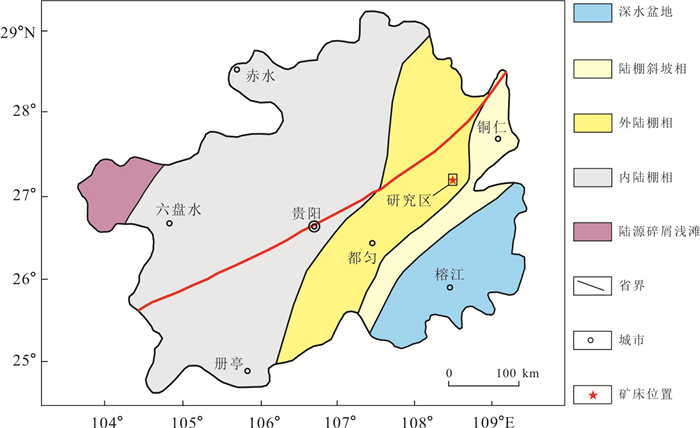
 下载:
下载:
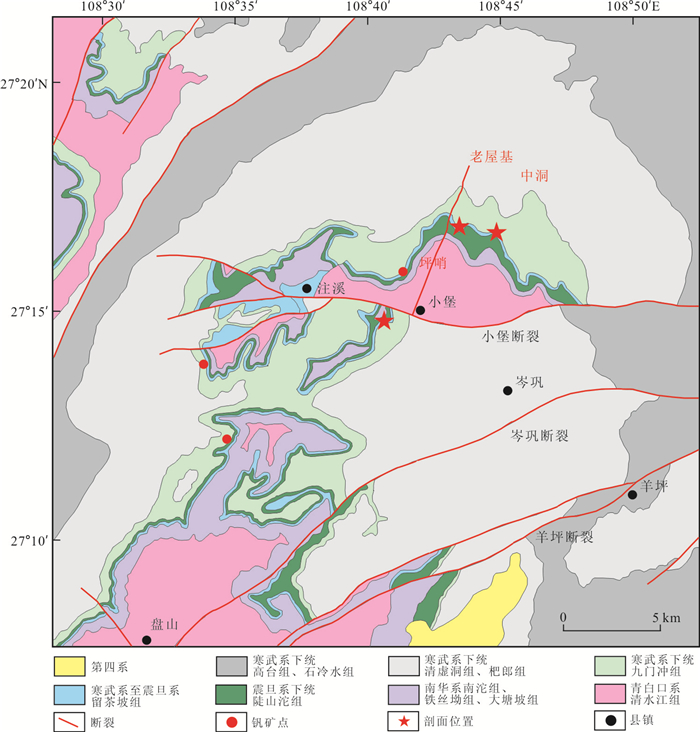

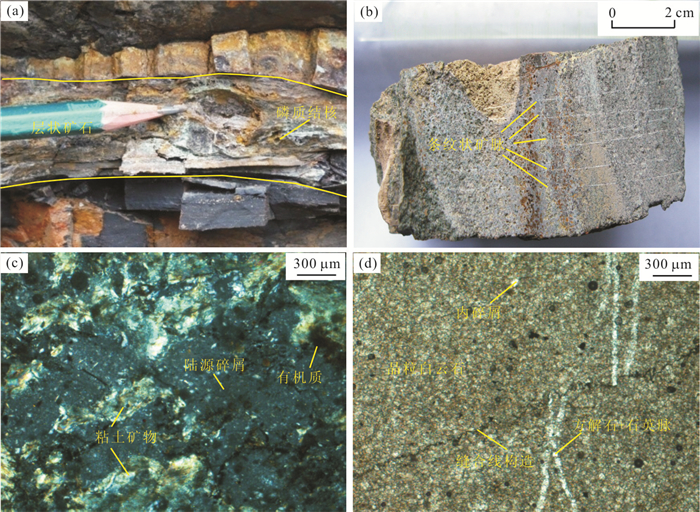
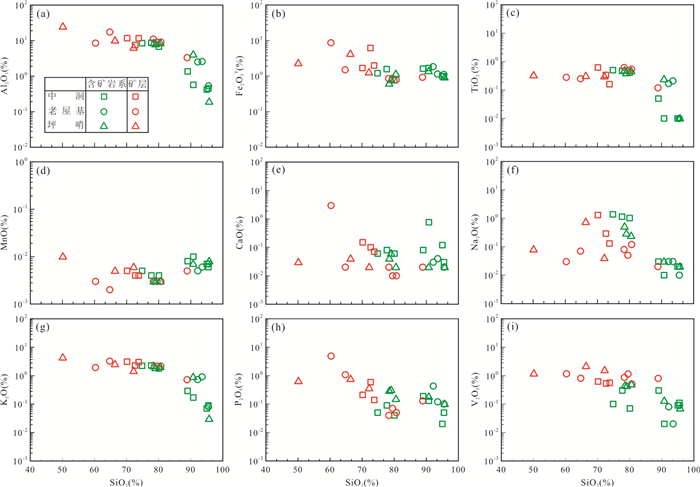
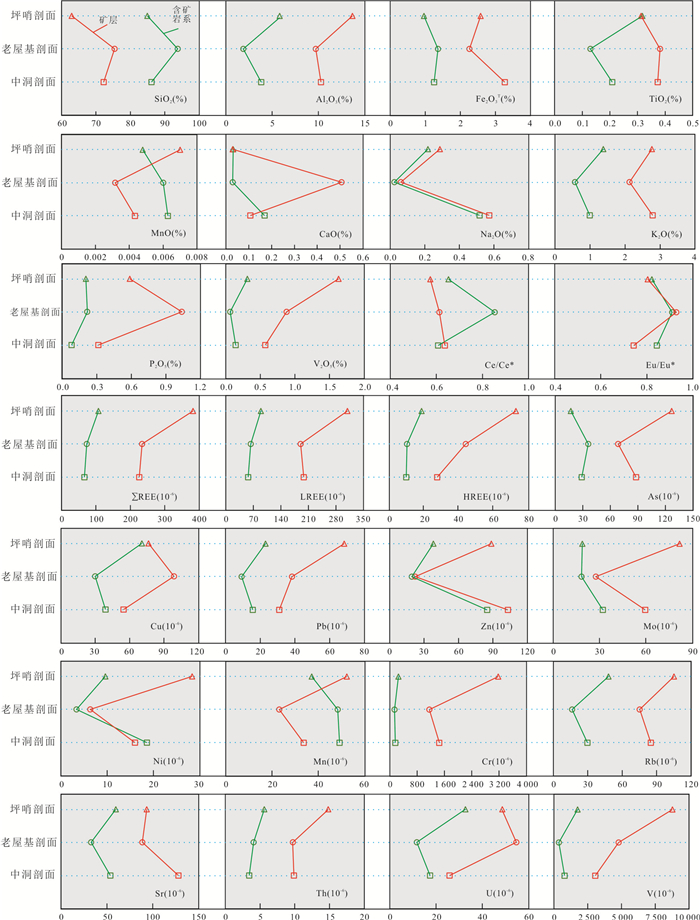

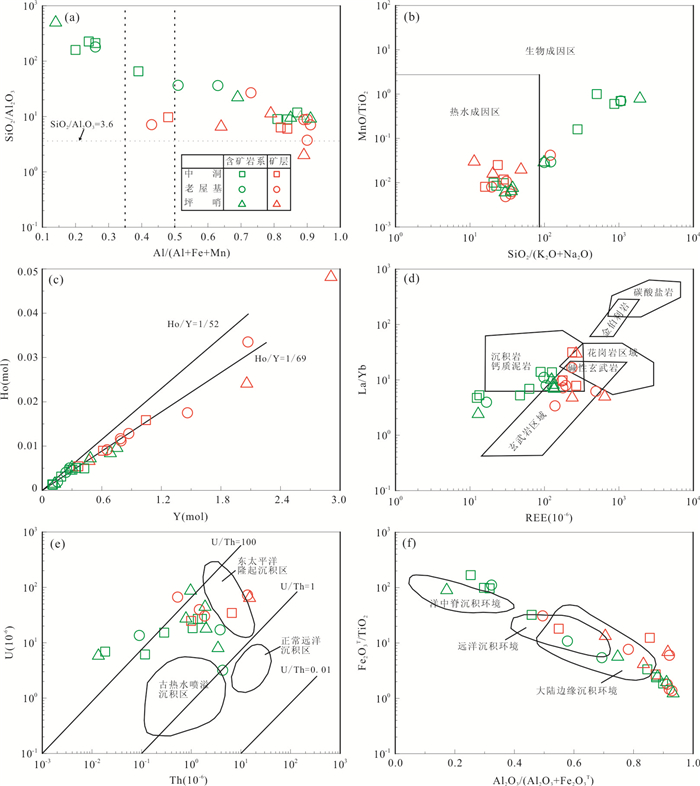

 百度学术
百度学术




